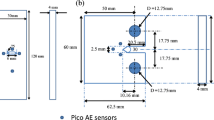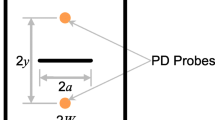Abstract
A new paradigm for damage diagnosis is proposed by developing a damage detection technique that eliminates the need for initially collected baseline data. Traditional techniques often identify damage by comparing the current data set with the reference data collected from the pristine condition of the structure being monitored. However, this conventional pattern comparison approach is shown to be vulnerable to other changes such as temperature variation that may not be relevant to defects of interest. One of potential advantages of the proposed reference-free approach is that false-alarm due to these undesirable variations could be minimized particularly for field applications where varying structural and environmental conditions impose significant challenges for damage diagnosis. In this paper, the effect of varying temperature on the previously developed reference-free crack detection technique is investigated using an aluminum plate with an increasing crack depth.
Similar content being viewed by others
References
Adams, D. (2007). Health Monitoring of Structural Materials and Components: Methods with Applications John Wiley and Sons.
Andrews, J. P., Palazotto, A. N., DeSimio, M. P., and Olson, S. E. (2008). “Lamb wave propagation in varying isothermal environments.” Int. Journal of Structural Health Monitoring, Vol. 7, No. 3, pp. 265–270.
Blitz, J. and Simpson, G. (1996). Ultrasonic methods of non-destructive testing, Chapman & Hall.
Buchanan, R. C. (2004). Ceramic materials for electronics, New York: Marcel Dekker.
Chang, P. C. and Liu, S. C. (2003b). “Recent research in nondestructive evaluation of civil infrastructures,” Journal of Materials in Civil Engineering, Vol. 15, No. 3, pp. 298–304.
Chang, P. C., Flatau, A., and Liu, S. C. (2003a). “Review paper: Health monitoring of civil infrastructure.” An International Journal of Structural Health Monitoring, Vol. 2, No. 3, pp. 257–267.
Cho, Y. (2000). “Estimation of ultrasonic guided wave mode conversion in a plate with thickness variation.” IEEE transactions on ultrasonics, ferroelectrics, and frequency control, Vol. 47, No. 10, pp. 591–603.
Ciolko, A. T. and Tabatabai, H. (1999). “Nondestructive methods for condition evaluation of prestressing steel strands in concrete bridges. Final report phase I: Technology review.” NCHRP Project 10-53.
Department of Defense Handbook. (2003). Metallic materials and elements for aerospace vehicle structures, MIL-HDBK-5J.
Doherty, J. E. (1987). Nondestructive evaluation chapter 12 in Handbook on experimental mechanics, Kobayashi, A. S. (ed), Society for Experimental Mechanics, Inc.
Fasel, T. and Todd, M. (2010). “An adhesive bond state classification method for a composite skin-to-spar joint using chaotic insonification.” Journal of Sound and Vibration, Vol. 329, No. 15, pp. 3218–3232
Fraden, J. (2001). Handbook of modern sensors, American Institute of Physics, New York.
Giurgiutiu, V. (2005). “Tuned lamb wave excitation and detection with piezoelectric wafer active sensors for structural health monitoring.” Journal of Intelligent Material Systems and Structures, Vol. 16, No. 4, pp. 291–305.
Giurgiutiu, V. and Zagrai, A. N. (2000). “Characterization of piezoelectric wafer active sensors.” Journal of Intelligent Material Systems and Structures,Vol. 11, No. 12, pp. 959–976.
Hellier, C. J. (2001). Handbook of non-destructive evaluation, McGraw-Hill, New York.
Kim, S. B. and Sohn, H. (2007a). “Instantaneous reference-free crack detection based on polarization characteristics of piezoelectric materials.” Smart Materials and Structures, Vol. 16, pp. 2375–2387
Kim, S. D., In, C. W., Cronin, K. E., Sohn, H., and Harries, K. (2007b). “A reference-free NDT technique for debonding detection in CFRP strengthened RC structures.” ASCE, Journal of Structural Engineering, Vol. 133, No. 8, pp. 1080–1091.
Montalvao, D., Maia, N. M. M., and Ribeiro, A. M. R. (2006). “A review of vibration-based structural health monitoring with special emphasis on composite materials.” The Shock and Vibration Digest, Vol. 38, No. 4, pp. 295–324.
Park, H. W., Kim, S. B., and Sohn, H. (2009). “Understanding a time reversal process in lamb wave propagations.” Wave Motion, Vol. 46, No. 7, pp. 451–467.
Popovics, J. (2004). “Non-destructive evaluation for civil engineering structures and materials.” Quantitative Nondestructive Structure Evaluation, Vol. 700, pp. 32–42.
Sohn, H. (2007). “Effects of environmental and operational variability on structural health monitoring.” A Special Issue of Philosophical Transactions of the Royal Society A on Structural Health Monitoring Vol. 365, pp. 539–560.
Sohn, H., Farrar, C., Hemez, F. M., Czarnecki, J. J., Shunk, D. D., Stinemates, D. W., and Nadler, B. R. (2004). A review of structural health monitoring literature: 1996–2001, Los Alamos National Laboratory Report, LA-13976-MS.
Sohn, H., Park, H. W., Law, K. H., and Farrar, C. R. (2007a). “Combination of a time reversal process and a consecutive outlier analysis for baseline-free damage diagnosis.” Journal of Intelligent Material Systems and Structures, Vol. 18, No. 4, pp. 335–346.
Sohn, H., Park, H. W., Law, K. H., and Farrar, C. R. (2007b). “Damage detection in composite plates by using an enhanced time reversal method.” ASCE Journal of Aerospace Engineering, Vol. 20, No. 3, pp. 141–151.
Staszewski, W., Boller, C., and Tomlinson, G. (2004). Health monitoring of aerospace structures, John Wiley and Sons.
Su, Z. and Ye, L. (2004). “Selective generation of lamb wave modes and their propagation characteristics in defective composite laminates.” Proceedings of the Institution of Mechanical Engineers, Part L: Journal of Materials: Design and Applications, Vol. 218, No. 2, pp. 95–110.
Su, Z., Ye, L., and Lu, Y. (2006). “Guided lamb waves for identification of damage in composite structures: A review,” Journal of Sound and Vibration, Vol. 295, pp. 753–780.
Van der Auweraer, H., and Peeters, B. (2003). “International research projects on structural health monitoring: An overview,” An International Journal of Structural Health Monitoring, Vol. 2, No. 4, pp. 341–358.
Viktorov, I. (1967). Rayleigh and lamb waves, New York: Plenum Press.
Wilcox, P. D., Lowe, M. J. S., and Cawley, P. (2001). “Mode and transducer selection for long range lamb wave inspection.” Journal of Intelligent Material Systems and Structures, Vol. 12, No. 8, pp. 553–565.
Yamanaka, K., Nagata, Y., and Koda, T. (1991). “Selective excitation of single-mode acoustic waves by phase velocity scanning of a laser beam.” Applied Physics Letters, Vol. 58, No. 15, pp. 1591–1593.
Author information
Authors and Affiliations
Corresponding author
Rights and permissions
About this article
Cite this article
Sohn, H. Reference-free crack detection under varying temperature. KSCE J Civ Eng 15, 1395–1404 (2011). https://doi.org/10.1007/s12205-011-1271-0
Received:
Revised:
Accepted:
Published:
Issue Date:
DOI: https://doi.org/10.1007/s12205-011-1271-0




